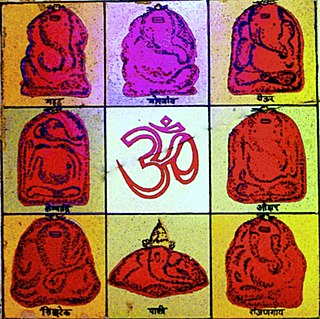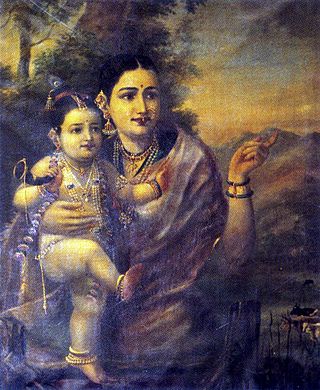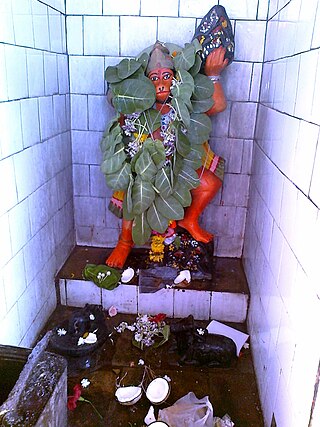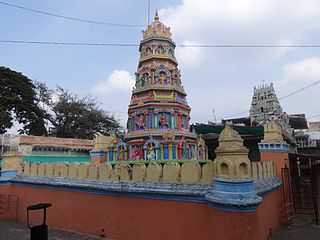
Ashtavinayaka literally means "eight Ganeshas" in Sanskrit. Ganesh is the Hinduism/Hindu deity of unity, prosperity, learning, and removing obstacles. The term refers to eight Ganeshas. Ashtavinayaka yatra trip refers to a pilgrimage to the eight Hindu temples in Maharashtra state of India that house eight distinct idols of Ganesh, in a pre-ascertained sequence. The Ashtavinayak yatra or pilgrimage covers the eight ancient holy temples of Ganesh which are situated around Pune. Each of these temples has its own individual legend and history, as distinct from each other as the murtis in each temple. The form of each murti of Ganesh and His trunk are distinct from one another. However, there are other temples of eight Ganesh in various other parts of Maharashtra; the ones around Pune are more well known than the former.

Krishna Janmashtamilit. ''Occasion of the birth of Krishna'', also known simply as Krishnashtami,Janmashtami, or Gokulashtami, is an annual Hindu festival that celebrates the birth of Krishna, the eighth avatar of Vishnu. According to the Hindu lunisolar calendar, it is observed on the eighth tithi (Ashtami) of the Krishna Paksha of Shraavana Masa or Bhadrapada Masa. This overlaps with August or September of the Gregorian calendar.

Hanuman Jayanti is a Hindu festival that celebrates the birth of the Hindu deity, and one of the protagonists of the Ramayana, Hanuman. In most states of India, the festival is observed on the full-moon day of the Hindu month of Chaitra. In Karnataka, Hanuman Jayanti is observed on Shukla Paksha Trayodashi, during the Margashirsha month or in Vaishakha, while in a few states like Kerala and Tamil Nadu, it is celebrated during the month of Dhanu. Hanuman Jayanti is observed on Mesha Sankranti in the eastern state of Odisha. This day is also observed as the Odia new year or Pana Sankranti. In northern India, it is celebrated on the fourteenth day of the lunar month of Kartika.

VallabhacharyaMahaprabhu, also known as Vallabha, Mahaprabhuji and Vishnuswami, or Vallabha Acharya, is a Hindu Indian saint and philosopher who founded the Krishna-centered PushtiMarg sect of Vaishnavism in the Braj(Vraj) region of India, and the Vedanta philosophy of Shuddha Advaita.

Pushtimarg, also known as Pushtimarg sampradaya or Vallabha sampradaya, is a subtradition of the Rudra Sampradaya (Vaishnavism). It was founded in the early 16th century by Vallabhacharya (1479–1531) and is focused on Krishna. A bhakti (devotional) school, Pushtimarg was expanded by the descendants of Vallabhacharya, particularly Gusainji. Its values are derived from and its universal-love-themed devotional practices center around the legendary amorous plays of youthful Krishna, such as those found in the Bhagavata Purana and those related to Govardhana Hill. Pushtimarg sampradaya recognizes Krishna by many names and epithets, such as Sri Nathji, Sri Navanitpriyaji, Sri Madanamohanji, Sri Mathureshji, Sri Gokulnathji, Sri Vittalnathji and Sri Dwarkadhishji.

Saptashrungi or Saptashringi is a site of Hindu pilgrimage situated 60 kilometres (37 mi) from Nashik in Indian state of Maharashtra. According to Hindu traditions, the goddess Saptashrungi Nivasini dwells within the seven mountain peaks. It is located in Nanduri, Kalwan taluka, a small village near Nashik in India. The Marathas and some Hindu tribes worship the goddess from a long time and some worship as their kuldaivat. There are 510 steps to climb the gad. Devotees visit this place in large numbers every day. The temple is also known popularly as one of the "three and half Shakti Peethas" of Maharashtra. The temple is also one among the 51 Shakti Peethas located on the Indian subcontinent and is a location where one of Sati's limbs, her right arm is reported to have fallen. Its half shaktipeeth among three and half shaktipeeth of Maharashtra.

The BAPS Shri Swaminarayan Mandir of Houston, Texas is a traditional Hindu temple built by the BAPS Swaminarayan Sanstha. It is in unincorporated Fort Bend County, Texas, within the extraterritorial jurisdiction (ETJ) of Stafford and with a Stafford mailing address.

Shri Swaminarayan Mandir, Mumbai is a Hindu temple (Mandir) and a part of the Swaminarayan Sampraday. This Swaminarayan Temple is located in the Bhuleshwar area of Mumbai and is the oldest Swaminarayan Mandir in Mumbai, being over a hundred years old.

Malayappa Swami is the current utsava murti in the Tirumala Venkateswara Temple, Tirumala. Malayappa Swami is worshipped during religious ceremonies and processions wherein it would be inappropriate to use the main deity. The two deities are worshipped equally and believed to be non-different in personality.

A Hindu priest may refer to either of the following:

The Vithoba Temple, officially known as Shri Vitthal-Rukmini Mandir, is a Hindu temple in Pandharpur, in the Indian state of Maharashtra. It is the main centre of worship for Vithoba, a form of the god Vishnu or Krishna, and his consort Rakhumai. The temple was built by King Vishnuvardhana of Hoysala Empire between 1108–1152 CE upon being convinced by the historical figure Pundalik. Also, there is an inscription in the temple, of a Hoysala King Vira Someshwara dating back to 1237 CE, which grants the temple a village for its upkeep. It is the most visited temple in Maharashtra. The Warkaris start marching from their homes to the temple of Pandharpur in groups called Dindi (procession) to reach on Aashadhi Ekadashi and Kartiki Ekadashi. A dip in the holy river Chandrabhaga, on whose banks Pandharpur resides, is believed to have power to wash all sins. All the devotees are allowed to touch the feet of the idol of Vithoba. In May 2014, the temple became the first in India to invite women and people from backward classes as priests.

Radha Ramana is a famous image of Radha Krishna worshiped in Hinduism. There is a famous temple of this deity in Vrindavana, Uttar Pradesh, India.

Govardhan Puja, also known as Annakut or Annakoot, is a Hindu festival in which devotees worship Govardhan Hill and prepare and offer a large variety of vegetarian food to Krishna as a mark of gratitude. For Vaishnavas, this day commemorates the incident in the Bhagavata Purana when Krishna lifted Govardhan Hill to provide the villagers of Vrindavan shelter from torrential rains. The incident is seen to represent how God will protect all devotees who take singular refuge in him. Devotees offer a mountain of food, metaphorically representing the Govardhan Hill, to God as a ritual remembrance and to renew their faith in taking refuge in God. The festival is observed by most of Hindu denominations all over India and abroad.

The Kataka Chandi Temple is an ancient temple dedicated to the Goddess Chandi, the presiding deity of Cuttack, Odisha, India. The temple is located nearby the banks of the Mahanadi River. It is famous for the annual Durga Puja and Kali Puja festivals. The Durga Puja festivities are prominent in Maa Katak Chandi temple which takes place for 16 days starting from dark fortnight of Ashwina Krishna Ashtami till Ashwina shukla navami and Vijayadashami. The goddess popularly called as Maa Kataka Chandi, sits and rules on the heart of the ancient city. She has four hands holding Paasha (noose), Ankusha (goad), gestures dispelling fear (Abhaya), and granting boon (Varada). She is worshiped as Bhuvaneshvari Mahavidya by Sevayatas belonging to Utkala Brahmins every day. Maa Chandi is worshipped in various incarnations of Durga during the puja. In Cuttack, people strongly believe Maa Katak Chandi as 'The Living Goddess'.

Jayanti Devi Temple lies at Jayanti Majri village hillock, which is 15 km from Chandigarh in Mohali district of Punjab.

Veerbhadra Temple, is situated in the holy Shri Kshetra Yadur, on the banks of holy river Krishna in Chikodi Taluka of Belagavi District, Karnataka, India, approximately 94 kilometres (58 mi) from Belgaum. It lies on the banks of the majestic Krishna River.

Sri Radha Raman Temple, is a Hindu temple situated in Vrindavan, India. It is dedicated to Krishna who is worshiped as Radha Ramana. This temple is counted as one of the Seven most revered ancient temples of Vrindavan along with Radha Vallabh Temple, Radha Damodar Temple, Radha Madanmohan Temple, Radha Govindji Temple, Radha Shyamsundar Temple and Radha Gokulnandan Temple. The temple houses the original Shaligram deity of Krishna alongside goddess Radha.
Shiv Shani Mandir, Dhori is a temple located in Bokaro District of Jharkhand. It is about 32 km from Bokaro and is located at the old B.D.O Office of Dhori, Phusro. The presiding deity of the temple, Sri Shiv, as well as Parvati, Ganesh, Hanuman, Kartikey and Shaneshwara or Lord Shani are worshiped with utmost reverence and devotion by multitudes of people from all over the locality. Unlike other pilgrimage centers, devotees here can perform puja, abhishek, or other religious rituals themselves. One of the unique aspects of the temple is that it is the only temple in the Bermo area where Lord Shiva and Lord Shani are established together. The people here believe that it is the benediction of the god that the locality is quite peaceful. The Shri Maa Banaso Temple and the Surya Temple of Badhkaro are the nearby attractions.

Madan Mohan Temple is a Hindu temple situated at Karauli, in the Indian state of Rajasthan. The temple is located on the banks of the Bhadravati River, a tributary of the Banas River in the hills of Aravali. It is located in the braj region. The temple is dedicated to Madan Mohan form of Krishna. In the central altar, Krishna is flanked with the icons of his consort Radha and Lalita on either side.



















